Cynefin – A Sense of Place: The Rose
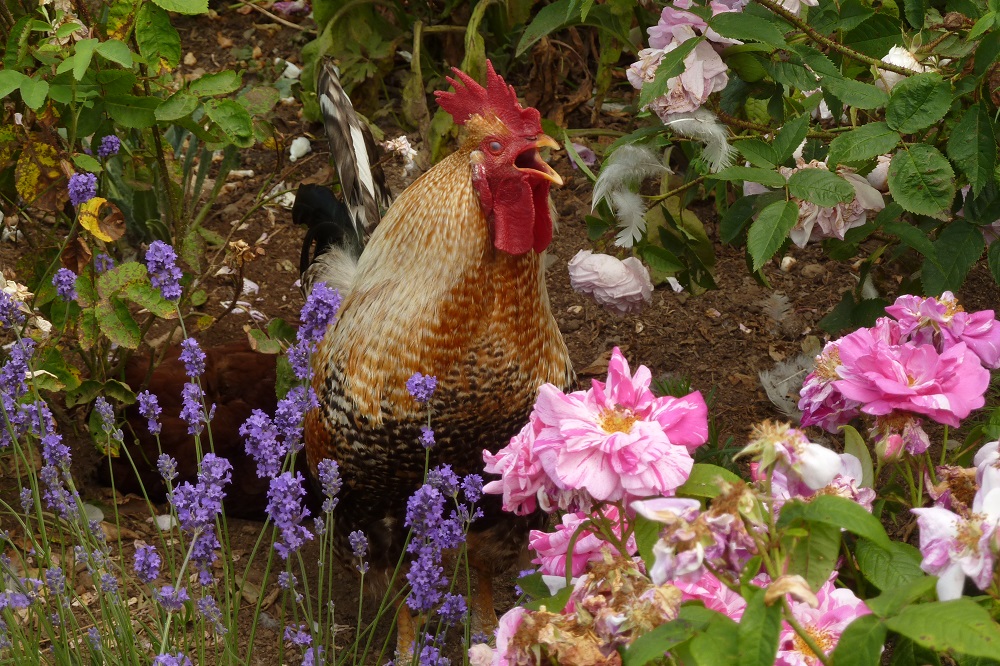
‘There is simply the rose; it is perfect in every moments of its existence’
Ralph Waldo Emerson
Gaynor Funnell
It’s the end of June and the uncut grasses at the end of the lane are already losing their spring freshness and show hints of tawny, fawn, russet. The white umbels of cow parsley are heavy-green with seeds whilst the leaning spires of foxgloves have replaced the bubble-gum pink of red campion.
Young blue-tits flit and dive through the collapsing undergrowth and in the dark of a holly bush, a robin sings quietly to itself.
June is the month for roses and the unusual spell of days of sun has been perfect for them. In the early morning and when the earth cools at the end of the day, their smell of musk, myrrh and orange-blossom, hangs heavy in the stillness, drifting through the shadows cast by the trees and the buildings.
I love roses, especially the old historical varieties. They can be difficult to grow – many flower only once in the summer, they can be untidy in the garden and have a habit of collapsing without support – but all are beautiful and most carry a delicious scent.
And as well as being beautiful, they have stories behind their names, for example Rosa Mundi, the so-called Rose of the World, reputedly named after fair Rosamund, the mistress of Henry II and one of the roses that symbolises the end of the War of the Roses.
The white rose was the emblem of the House of York, whilst red represented the House of Lancaster. Mundi is a mix of the two colours – imagine raspberry jam swirled into vanilla ice cream, the pattern different every time you do it.
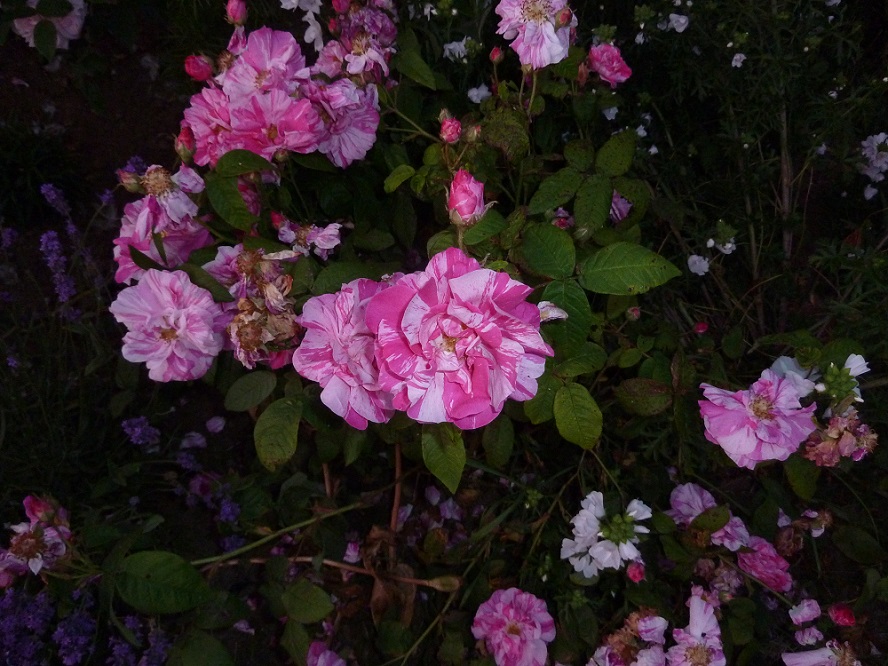
Damask
I’ve dug, chiselled and potted over one hundred varieties here, have planted them in borders, to cover walls and buildings and over trees. Some have taken a dislike to the damp Welsh weather and thin soil and have refused to grow, but others have thrived.
Ispahan, a perfection in Schiaparelli pink, is collapsing gracefully over the overgrown box hedge under the weight of her flowers. They have quartered swirls and curls that feel like silk and some have a tiny, green button eye that becomes visible when the flowers are fully open.
The blooms have a quality that make them appear to glow at dusk and have a delicious, sweet perfume, called Old Rose by the experts in such things.
Ispahan comes from the city of Isfahan in Persia – now Iran – so the heat and dryness of the last week is ideal for her. She is a damask rose and was introduced into Europe around 1894, although other damask roses were brought back earlier by returning crusaders.
Her flowers last for about six weeks, which is a long time for an old rose, and she is glorious when in full bloom.
In the opposite border, outlined by the dark of a conifer, Hebe’s lip trembles in the slight breeze. Her ivory tissue-paper petals are encircled with a cherry-red lip liner that fades as the sun kisses them, which then fold gently over the starburst of buttercup-yellow stamens nestling in her centre.
She arches delicately over the mauve spikes of lavender, and has a Titania’s bower smell of musk surrounding her – strong and heady, lilac mixed with violets.
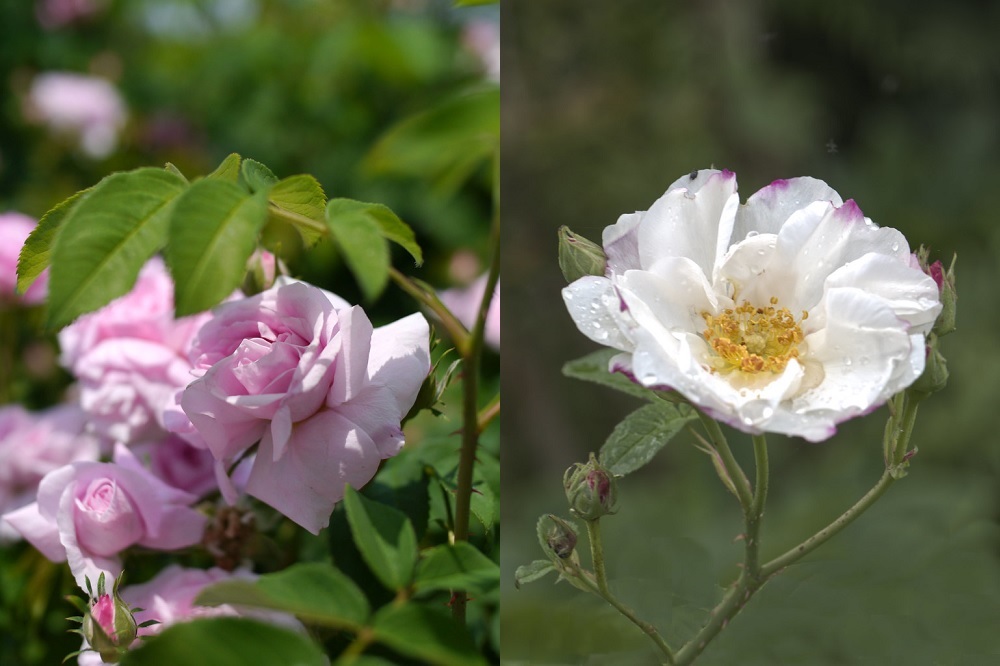
Extravagant
Souvenir de Madame Leonie Viennot is pulling herself out of the large container I planted her in and is trying to escape over the roof of the barn. She is blowsy and extravagant and throws herself over every surface she touches with abandonment.
Her flowers are the colour of the blush on a ripe peach and smell like raspberries freshly picked. She was very popular during the 1920’s, I imagine as a cut flower, and was often grown in a conservatory as she can be temperamental in cold gardens.
On the sunny side of the barn, Mutablis winds her way amongst the orange-brown of a carex grass and allows the cerise-flowered viticella clematis Etoile Rose to scramble through her. Mutablis originates from China and in flower looks like a bush covered with apricot, crimson and fuchsia butterflies.
Mutablis is the latin for change and that is what her flowers do – they start one colour and over a few days, change to another. The five-petaled silk-like blooms only have a faint smell but I forgive her for this minor fault because in full bloom, she is simply stunning.
There is a garden in Italy – La Landriana – where the owner has planted 300 of these roses amongst grasses to create a rose forest; a forest full of flower-butterflies. I hope to visit one day.
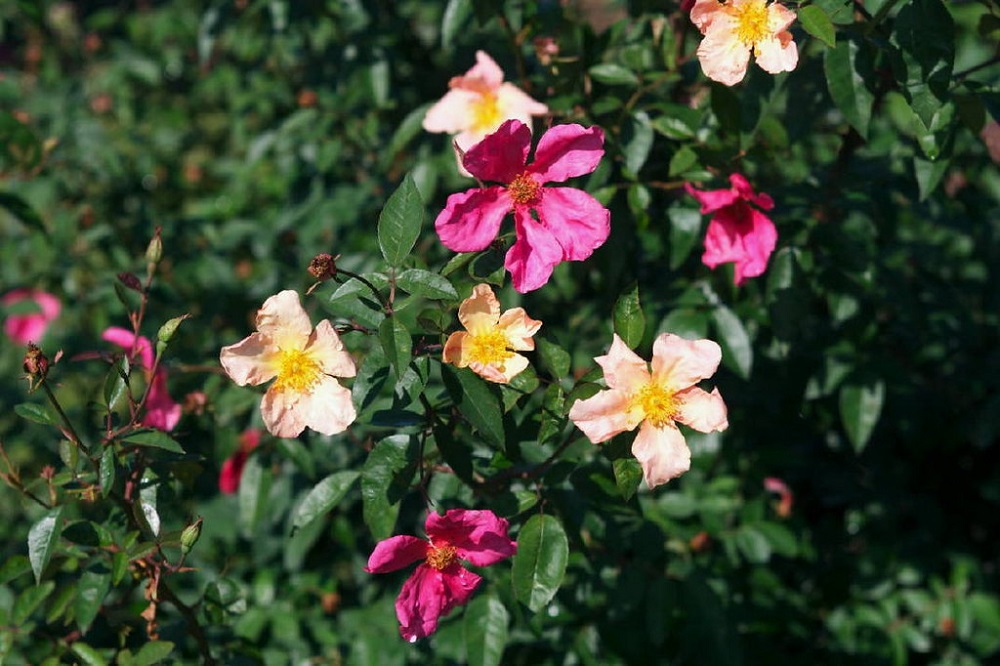
Sumptuous
Souvenir de la Malmaison grows to about four feet tall and her leaves will be spotted with black by the time she has finished flowering as the usual dampness of the Welsh weather doesn’t agree with her.
Souvenir was created in 1843 in Lyon in France and named after Empress Josephine’s famous rose garden at Chateau de Malmaison in France where Josephine lived with Napoleon Bonaparte.
Between 1804 and 1814, this contained the largest collection of roses in the world with over 200 varieties.
Interestingly, despite being at war, Napoleon allowed the transport of roses from England, and shipments of roses were able to cross the blockades.
As she died in 1814, Josephine never got to see this sumptuous variety, with its blush and powder pink cupped blooms, that fold into four quarters around a central eye like the encircling leaves of a cabbage – it was named in memory of her.
I’m hoping this ‘Queen of delights’ will grow taller so I can smell her rich, heady, spicy-hyacinth perfume at head height, rather than having to bend down, and even if she only produces one flower a year, it will be worth it.
Wild roses
As special and beautiful as these old roses are, the real stars of June are the wild roses; the dog rose, the briar rose, the field rose. All along the lane you can see them climbing, sprawling, cascading and clambering into trees, hooking themselves through the ivy they share a space with.
In Cromlech field, one has draped itself over an elder tree, all afroth with cream, and is entwined with a butter-yellow honeysuckle – by a happy coincidence, all three flowering at the same time.
The colours of these roses vary. Some are the palest of pinks, that drift to white as they age, others hint of madder, salmon, watermelon. All with a central boss of the most golden of stamens.
Some have a sweet, floral, musky aroma, whilst others carry no scent at all. In autumn, trails and streamers of scarlet hips adorn the hedgerows.
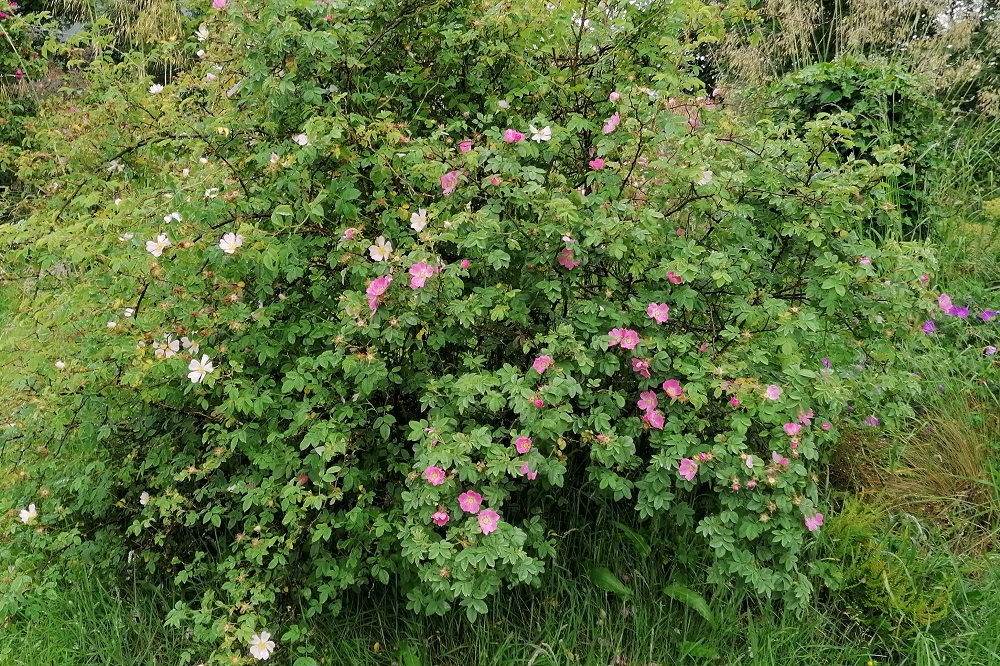
Self sewn
I made rose hip syrup one year as it’s supposed to prevent colds. One teaspoon contains half the vitamin C needed for a child’s daily intake, the hips containing 20 percent more vitamin C than oranges.
The process is fiddly and sticky and the resulting peach coloured, silky syrup has a subtle tropical tang with a hint of almond, but I left the hips for the birds the following years.
A wild rose has decided to grow in a border at the side of the house. I decided to let it do its thing and now the straggling bush is the same height as me and twice as wide.
The flowers are cerise fading through the palest of pinks to cream, then white, and each of the five petals have a slight dip in the centre so they resemble a heart. The perfume of the individual flowers isn’t strong but when you stand up close, the surrounding air breathes rose.
Last year, I found two other seedlings, and carefully teased their fragile roots from the thin soil they’d decided to settle in.
I planted one on the final resting place of my beloved dog Rosie. She’s buried underneath the tree where she used to wait for a squirrel to appear, remaining convinced to the end that she’d catch one. It might be too dark for the rose to thrive, but I figured she’d do her best.
The other I’ve planted in a pot, so I can take it with me to grow new memories when I have to move.
Gaynor Funnell is the winner of the Nigel Jenkins award for 2022. We are delighted to be publishing a series about Penbanc over the coming months, with support from the H’mm Foundation.
You can read the serialisation so far here and you can discover other writing by Gaynor on Nation.Cymru by following her link on this map
Support our Nation today
For the price of a cup of coffee a month you can help us create an independent, not-for-profit, national news service for the people of Wales, by the people of Wales.




